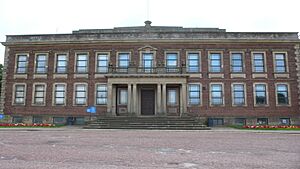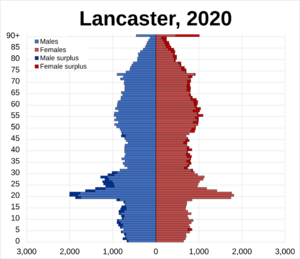City of Lancaster facts for kids
Quick facts for kids
Lancaster
|
||
|---|---|---|
|
City and non-metropolitan district
|
||
|
|
||
|
||
| Motto(s):
"Luck to Loyne"
|
||

Lancaster shown within Lancashire
|
||
| Sovereign state | United Kingdom | |
| Country | England | |
| Region | North West England | |
| Ceremonial county | Lancashire | |
| City status | 14 May 1937 | |
| Administrative HQ | Lancaster (Town Hall) Morecambe (Town Hall) |
|
| Government | ||
| • Type | Non-metropolitan district | |
| • Body | Lancaster City Council | |
| Area | ||
| • Total | 222.4 sq mi (575.9 km2) | |
| Area rank | 79th | |
| Population
(2005 est.)
|
||
| • Total | 146,038 | |
| • Rank | 146th | |
| • Ethnicity | 97.8% white | |
| Ethnicity (2021) | ||
| • Ethnic groups |
List
|
|
| Religion (2021) | ||
| • Religion |
List
51.8% Christianity
38.1% no religion 6.6% not stated 1.6% Islam 0.6% other 0.4% Hinduism 0.4% Buddhism 0.1% Sikhism 0.1% Judaism |
|
| Time zone | UTC+0 (Greenwich Mean Time) | |
| • Summer (DST) | UTC+1 (British Summer Time) | |
| Postcode areas |
LA
|
|
| Dialling codes | 01524 (Lancaster) 015242 (Hornby-with-Farleton) |
|
| Vehicle registration prefix | P | |
| GSS code | E07000121 | |
| NUTS 3 code | UKD44 | |
| ONS code | 30UH | |
| OS grid reference | SD475615 | |
| Motorways | M6 A601(M) |
|
| Major railway stations | Lancaster (B) | |
| Councillors | 61 | |
| MPs | Cat Smith (L) Lizzi Collinge (L) |
|
| Police area | Lancashire | |
| Fire service | Lancashire | |
| Ambulance service | North West | |
The City of Lancaster is a special area in Lancashire, England. It's called a "city" because it has a special status. The main town in this area is also called Lancaster.
The City of Lancaster district also includes other towns like Carnforth, Heysham, and Morecambe. It covers a large countryside area too. Many parts of this countryside are known for their amazing natural beauty. These include parts of the Yorkshire Dales National Park and special areas like Arnside and Silverdale and the Forest of Bowland.
Contents
Discovering Lancaster's Past
The town of Lancaster has a very long history. Its first known official document, called a charter, was written in 1193. This document gave the town special rights. Later, in 1337, another charter allowed Lancaster to have its own mayor.
In 1937, Lancaster was officially given "city status." This means it was recognized as an important city.
How the Modern City of Lancaster Was Formed
The current City of Lancaster district was created on April 1, 1974. This happened because of a law called the Local Government Act 1972. Several smaller areas joined together to form the new, larger district. These areas included:
- Carnforth Urban District
- Lancaster Municipal Borough
- Lancaster Rural District
- Lunesdale Rural District
- Morecambe and Heysham Municipal Borough
When the new district was formed, it was given "borough status." This allowed the head of the local council to be called a mayor, continuing a tradition that goes all the way back to 1337. The special "city status" that old Lancaster had was also passed on to this new, larger district.
Since 2016, a small part of the Yorkshire Dales National Park has also been included in the district.
How Lancaster is Governed
The City of Lancaster is managed by the Lancaster City Council. This council handles local services like waste collection and housing. Bigger services, like education and major roads, are managed by the Lancashire County Council.
Many smaller areas within the district have their own local councils called civil parishes. These are the third level of local government.
Who Leads the Council?
| Lancaster City Council | |
|---|---|
 |
|
| Leadership | |
|
Mayor
|
|
|
Leader
|
|
|
Mark Davies
Since 2022 |
|
| Structure | |
| Seats | 61 councillors |
 |
|
|
Political groups
|
|
|
Length of term
|
4 years |
| Elections | |
| First past the post | |
|
Last election
|
4 May 2023 |
|
Next election
|
6 May 2027 |
| Meeting place | |
 |
|
| Town Hall, Marine Road East, Morecambe, LA4 5AF | |
The mayor in Lancaster has a mostly symbolic role. The real political decisions are made by the leader of the council.
Here are the leaders of the council since 1993:
| Councillor | Party | From | To | |
|---|---|---|---|---|
| Stanley Henig | Labour | pre-1993 | May 1999 | |
| Tricia Heath | Morecambe Bay Independents | May 1999 | May 2003 | |
| Ian Barker | Labour | May 2003 | May 2007 | |
| Roger Mace | Conservative | 21 May 2007 | 4 Feb 2009 | |
| Abbott Bryning | Labour | 4 Feb 2009 | May 2009 | |
| Stuart Langhorn | Liberal Democrats | 18 May 2009 | May 2011 | |
| Eileen Blamire | Labour | 23 May 2011 | May 2019 | |
| Erica Lewis | Labour | 20 May 2019 | May 2021 | |
| Caroline Jackson | Green | 17 May 2021 | May 2023 | |
| Phillip Black | Labour | 22 May 2023 | 13 Nov 2024 | |
| Caroline Jackson | Green | 25 Nov 2024 | ||
Who is on the Council?
After the elections in 2023, the council is made up of different political groups:
| Party | Councillors | |
|---|---|---|
| Green | 23 | |
| Labour | 21 | |
| Liberal Democrats | 7 | |
| Conservative | 5 | |
| Morecambe Bay Independents | 3 | |
| Independent | 2 | |
| Total | 61 | |
The next local election is planned for 2027.
Where Does the Council Meet?
The council uses two main buildings for its meetings: Lancaster Town Hall and Morecambe Town Hall. The larger meetings are held in Morecambe Town Hall. Lancaster Town Hall is used for smaller meetings and for the council's offices.
Understanding Lancaster's People
In 2011, the City of Lancaster had about 138,375 people living there. About 33.5% of homes were married couples. Around 31.9% were single-person homes.
The population density was about 233 people per square kilometer. This means how many people live in a certain area. For every 100 females, there were about 91.8 males.
Population Changes Over Time
The number of people living in the City of Lancaster has changed a lot since 1801. The table below shows how the population has grown over the years.
| Population growth in City of Lancaster since 1801 | |||||||||||||||||||||||||||||||||||||||||||||||||||||||||||||||||||||||||||||
|---|---|---|---|---|---|---|---|---|---|---|---|---|---|---|---|---|---|---|---|---|---|---|---|---|---|---|---|---|---|---|---|---|---|---|---|---|---|---|---|---|---|---|---|---|---|---|---|---|---|---|---|---|---|---|---|---|---|---|---|---|---|---|---|---|---|---|---|---|---|---|---|---|---|---|---|---|---|
|
|
|
|||||||||||||||||||||||||||||||||||||||||||||||||||||||||||||||||||||||||||
| Source: Vision of Britain | |||||||||||||||||||||||||||||||||||||||||||||||||||||||||||||||||||||||||||||
Religions in Lancaster
In 2011, most people in Lancaster identified as Christian (65.9%). About 24.5% said they had no religion. Other religions like Muslim, Buddhist, Hindu, Jewish, and Sikh were also present.
| 2011 UK Census | City of Lancaster | Lancashire | England |
| Population | 138,375 | 1,134,974 | 49,138,831 |
| Christian | 65.9% | 68.8% | 59.4% |
| Muslim | 1.3% | 4.8% | 5.0% |
| No religion | 24.5% | 19.2% | 24.7% |
The area has churches for different Christian groups.
Lancaster's Economy and Jobs
In 2001, there were about 97,365 people aged 16 to 74 in the City of Lancaster. Many of these people were working.
| 2001 UK Census | City of Lancaster | Lancashire | England |
| Population of working age | 97,365 | 814,434 | 35,532,091 |
| Full-time employment | 33.5% | 39.2% | 40.8% |
| Part-time employment | 12.7% | 12.2% | 11.8% |
| Self employed | 7.8% | 8.2% | 8.3% |
| Unemployed | 3.6% | 2.9% | 3.3% |
| Retired | 14.9% | 15.0% | 13.5% |
The most common jobs in Lancaster were in:
- Shops and wholesale (16.7%)
- Health and social work (14.2%)
- Education (11.4%)
- Manufacturing (11.2%)
Other jobs included property services, construction, hotels, transport, and public administration. A higher percentage of people worked in agriculture compared to the rest of England.
Media and Local News
People in the Lancaster area can watch TV from BBC North West and ITV Granada.
For radio, there are stations like BBC Radio Lancashire and BBC Radio Cumbria. Local stations include Heart North West, Smooth North West, and Greatest Hits Radio Lancashire. There's also a community radio station called Beyond Radio for Lancaster and Morecambe.
Towns and Villages in the District
Local Parishes
Most of the district is divided into smaller areas called civil parishes. Some of these parishes, like Carnforth and Morecambe, have their own "town councils."
Here are some of the civil parishes in the City of Lancaster district:
- Aldcliffe-with-Stodday
- Arkholme-with-Cawood
- Bolton-le-Sands
- Borwick
- Burrow-with-Burrow
- Cantsfield
- Carnforth
- Caton-with-Littledale
- Claughton
- Cockerham
- Ellel
- Gressingham
- Halton-with-Aughton
- Heaton-with-Oxcliffe
- Hornby-with-Farleton
- Ireby
- Leck
- Melling-with-Wrayton
- Middleton
- Morecambe
- Nether Kellet
- Over Kellet
- Over Wyresdale
- Overton
- Priest Hutton
- Quernmore
- Roeburndale
- Scotforth
- Silverdale
- Slyne-with-Hest
- Tatham
- Thurnham
- Tunstall
- Warton
- Wennington
- Whittington
- Wray-with-Botton
- Yealand Conyers
- Yealand Redmayne
Lancaster's Twin Towns
Lancaster has special friendships with several towns and cities around the world. These are called "twin towns" or "sister cities." They often share cultural events and visits.
- Perpignan, France (since 1962)
- Rendsburg, Germany (since 1968)
- Aalborg, Denmark (since 1982)
- Lublin, Poland (since 1994)
- Växjö, Sweden (since 1996)
Associate Towns
Lancaster also has "associate towns," which are similar friendships:
- Almere, Netherlands
- Viana do Castelo, Portugal











